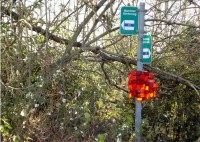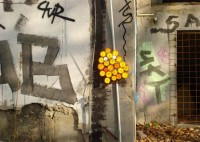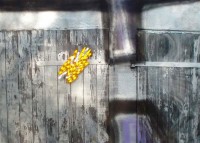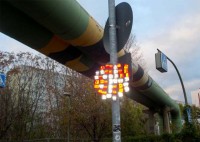Tour through Lichtenberg – Four locations
The attention of passers-by is drawn towards unspectacular, but very typical locations in Lichtenberg by so-called “markers”. What happened there, what is happening there now, or what could or will happen there in the future? Why is this place special?
At the selected locations, I installed markers made from used bicycle reflectors that I had found in Lichtenberg. These objects light up differently in various lighting situations for those who are walking, cycling or driving past.
Location 1: Birkhauserstr., ‘Ortsende’ estate, Wartenberg

Here, in the very north of Berlin, the landscape is rural and reminds us that the present-day district of Lichtenberg originally consisted of a number of villages.
The marker was attached to the directional signs for the so-called “Barnim villages walking path”, a popular route that leads strollers through meadows, fields and old fruit plantations.
Location 2: Gehringstr./corner of Rhinstr./Wollenbergerstr.

A parallel world exists here on a huge site with disused GDR prefab tower blocks. A Greek investor once bought this site, which has now become overgrown with trees and bushes.
Around 150 people lived here, mainly from eastern European countries. Gas cylinders and open fires were used to provide heating.
The site has since been cleared and sealed off. Gaps in the fencing can still be found.
Location 3 “Weisse Taube” allotment gardens, Siegfriedstr./Landsberger Allee

Allotment gardens in Berlin served as hide-outs for victims of persecution during the Nazi era. The presenter and entertainer Hans Rosenthal is one of the most well-known survivors who hid in an allotment. “Weisse Taube” was one of the garden areas where he hid.
During the GDR era, fruit and vegetables that were difficult to come by were grown in these allotments, and these gardens still serve as inexpensive living quarters and oases of nature today.
Location 4 Buchberger Strasse, before the tunnel that leads to the ‘Viktoriastadt’ quarter

he corner of Türrschmidstrasse and Kaskelstrasse represents the easterly end of ‘Victoriastadt’, a refurbished residential area where young, relatively affluent families live.
When you pass through the passageway at the S-Bahn railway station, you leave Victoriastadt behind you and enter a different world: apartment blocks, disused buildings and commercial premises, idle sites with ruins.
The marker can only be seen by those coming from the train station and turning not towards the fancy ‘Victoriastadt’ quarter, but towards the non-refurbished area.
